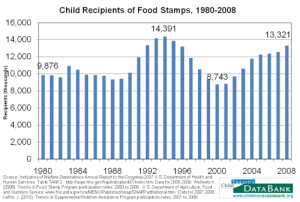It’s a SNAP: Food Stamps Benefit Children, Families and Communities
Several scientific studies have found that America’s food stamp program, also known as the Supplemental Nutrition Assistance Program (SNAP), produces measurable benefits for children, families, and communities, including better pregnancy outcomes and increased food security. In 2010, more than 40 million people received supplemental nutrition assistance (about $133 per person on average each month.) In 2008, before the recession–which is the latest data with ages—one in six children in America, or more than 13 million children, received food stamps. See our brief for more trends.
According to the Institute for Research on Poverty, women with access to food stamps in the last three months of their pregnancy had improved outcomes, as measured by higher infant birth weights and reduced infant mortality. The largest effects were for births to African-American mothers, but outcomes were significantly improved for both African-Americans and whites.
Also, when controlling for other relevant factors, several studies suggest that receipt of food stamps increases food security, defined by the U.S. Department of Agriculture (USDA) as having “access at all times to enough food for an active, healthy life for all household members.”
Because food stamps directly supplement income (allowing families to spend additional dollars on food or other needs), they also strengthen families’ economic security. And, the additional spending from food stamps creates “ripple effects” throughout the economy. USDA estimates that for every additional dollar in food stamp benefits, $1.84 was generated through this economic multiplier effect.
© Copyright 2024 ChildTrendsPrivacy Statement
Newsletter SignupLinkedInThreadsYouTube
